Green building design is transforming the construction industry by offering sustainable solutions that reduce environmental impact and boost energy efficiency.
But what exactly makes a building “green”? And how can you as a housing professional create more sustainable buildings?
In this 10-minute read, we’ll explore the key features and benefits of green buildings, from energy-efficient materials to sustainable technologies.
Curious about how incorporating these practices can enhance your projects and help your business stay ahead in the growing green construction movement? Then don’t miss the green features section with expert tips on green building practices you can start implementing today.
What Is A Green Building?
The term “green building” refers to structures that are environmentally responsible and resource-efficient throughout their life cycle (from design to demolition). Green buildings reduce energy use, conserve natural resources, and promote human health, all while minimizing their overall environmental impact.
They achieve this by prioritizing sustainability, energy efficiency, and occupant well-being with the materials, construction methods, and maintenance requirements. By enhancing occupant well-being and reducing carbon emissions in these ways, green buildings are an important piece in the global puzzle of sustainable development promotion.
Learn more about the key objectives of green design in the next section.
Key Objectives of Green Building Design
At the heart of green building design are a few guiding principles that not only help the environment but also add real value to any project:
- Energy Efficiency: The goal here is to minimize energy use, typically through smart features like advanced insulation, energy-efficient HVAC systems, or Energy Star appliances. For example, imagine adding solar panels to a project. Not only does this reduce reliance on traditional power grids, but it also helps buildings hit net zero energy targets, something that is more and more popular in today’s market.
- Water Conservation: Cutting down on water usage is another major focus. That is why green buildings often include features like low-flow water fixtures or rainwater harvesting systems. For example, by reusing greywater for irrigation, a commercial building can slash water consumption significantly.
- Indoor Environmental Quality: It’s more than just air conditioning. Indoor air quality is about optimizing natural lighting, better ventilation, and using materials that don’t release toxic fumes (like VOCs). For instance, using low-emittance windows cuts down on heating costs and enhances the comfort of the space by controlling how much heat gets in.
- Waste Reduction: Green buildings focus on reducing waste not just during operation but right from construction. Think reclaimed wood or recycled steel. These materials not only have a lower environmental footprint but also add character to a space. Also, operational waste is managed through composting and recycling programs to ultimately minimize the amount that ends up in landfills.
Certification & Standards
Achieving certifications like LEED (Leadership in Energy and Environmental Design) from the Green Building Council, BREEAM, or Energy Star is an important goal for green building practices. These certification systems assess buildings based on their energy performance, resource use and impact on the natural environment. And when your project adheres to this green building rating system, it demonstrates a commitment to sustainability and ensures the building meets rigorous standards for environmental responsibility.
Environmental and Economic Benefits
Green building concepts benefit more than just the environment. It can also benefit your budget and your client’s wallet.
- Environmental Benefits: By integrating renewable energy sources like solar panels or geothermal systems, green buildings dramatically reduce their reliance on non-renewable energy and can even reach the goal of becoming net zero energy buildings. Plus, using sustainable materials like bamboo or eco-friendly insulation cuts down on resource depletion and helps preserve our planet’s natural resources.
- Economic Benefits: It’s true, the upfront cost of a sustainable building might be a bit higher. However, the long-term savings more than make up for the initial investment. Why? With an emphasis on energy efficiency, these resource efficient buildings cost far less to run. For example, Green Building Council LEED certified buildings could see up to 25% lower energy bills, which adds up over time. Plus, green buildings tend to have higher resale values and attract tenants who are willing to pay a premium for eco-friendly features.
- Health & Productivity: One of the most overlooked benefits is how green buildings improve the well-being of the people who use them. With cleaner air, more natural light and fewer toxic materials, occupants feel healthier and are more productive. Studies even show that people working in green commercial buildings tend to have higher job satisfaction and even fewer sick days. That makes green buildings a win for both employees and employers.
Green & Sustainable Features Being Included in New Builds
As the demand for green buildings grows, the range of eco-friendly features available for new construction and remodels has expanded. Let’s dive into some key features and sustainable building concepts like sustainable lumber and improved insulation to see how you can incorporate them into your next project.
1. Sustainable Lumber
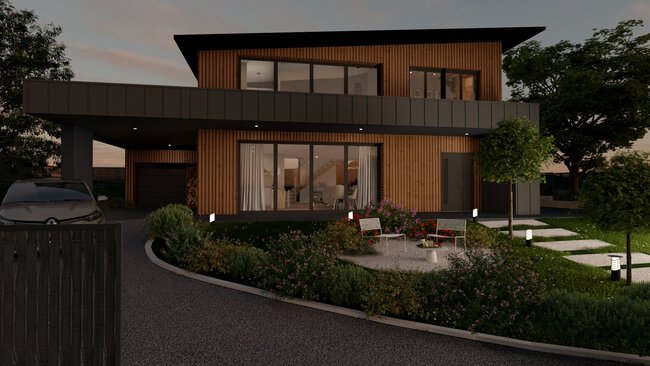
About this Green Feature:
Sustainable lumber is sourced from responsibly managed forests that promote forest regeneration and biodiversity. This type of wood usually comes with certifications like FSC (Forest Stewardship Council), which means it’s harvested with minimal environmental impact. Unlike traditional timber products, sustainable lumber supports reforestation efforts and helps sequester carbon. That makes it an excellent option for green projects that try to prioritize resource efficiency and reduce carbon footprints.
Tips for Incorporating Sustainable Lumber in Your Projects:
- Source Locally: Local lumber reduces transportation emissions and supports regional forestry initiatives.
- Use Certified Wood: Always go with FSC-certified lumber or a similar option where you live.
- Pair with Recycled Wood: Incorporate reclaimed wood for a unique design that reduces the need for virgin materials.
2. Improve Insulation
About this Green Feature:
Good insulation is a core piece of energy-efficient buildings. It reduces heat transfer which lowers the need for excessive heating or cooling. While any kind of insulation can improve the energy efficiency of a building, materials like fiberglass, hemp, cellulose, wool, or cotton — often made from recycled or renewable sources—are popular in sustainable buildings.
Tips for Incorporating this Green Feature in Your Projects:
- Seal Air Leaks: Ensure gaps and leaks around windows and doors are sealed tightly to optimize insulation performance and reduce energy use.
- Prioritize High R-Value: Make sure you meet green building codes by choosing materials with the correct R-values for your climate.
- Use Recycled or Natural Materials: The most eco-conscious builders should look for materials like recycled denim or hemp wool for the greatest benefits when it comes to indoor air quality and sustainability. Even traditional fiberglass insulation is made from a high amount of recycled materials.
3. Energy Star Appliances
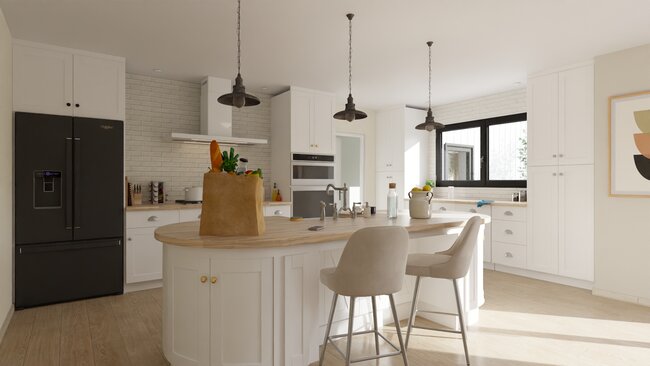
About this Green Feature:
Energy Star appliances are a no-brainer for anyone who wants to reduce energy costs. These appliances are designed to meet strict energy efficiency guidelines set by the EPA, which means they consume less electricity while performing just as well, or even better, than standard models. For green builders, incorporating Energy Star-certified fridges, dishwashers, and HVAC systems translates to lower utility bills, reduced energy use, and a smaller carbon footprint.
Tips for Incorporating Energy-Efficient Appliances in Your Sustainable Building Projects:
- Upgrade High-Use Areas First: Prioritize energy-hungry areas like kitchens and laundry rooms where Energy Star appliances can have the biggest impact on overall energy consumption.
- Consider Whole-Building Efficiency: Use Energy Star appliances alongside other energy-saving systems, like programmable thermostats, to maximize the building’s overall energy performance.
Take Advantage of Rebates: Many state and local governments offer rebates or incentives for installing Energy Star products. This can help reduce upfront costs for you and your clients.
4. Programmable Thermostats
About this Green Feature:
Programmable thermostats are a simple yet highly effective way to improve energy efficiency and indoor environmental quality. They let you control temperature settings in different zones and automate temperature changes throughout the day. Plus, you can easily incorporate this green feature into existing buildings and HVAC systems.
Tips for Incorporating this Sustainable Design Feature in Your Green Buildings:
- Customize for Occupancy Patterns: Program thermostats to adjust temperatures based on building occupancy, i.e. turn the heat down at night or when no one’s home to save energy.
- Zoning Matters: Pair programmable thermostats with zoning systems, so different areas of the building can be heated or cooled independently, based on usage.
Integrate Smart Tech: Look for smart programmable thermostats that you can control remotely.
5. Solar & Geothermal Energy
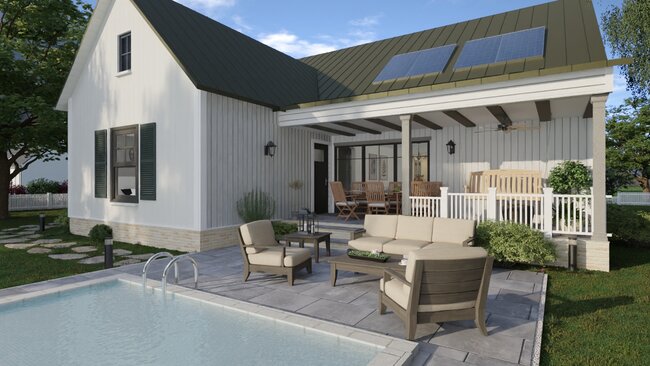
About this Green Feature:
Harnessing solar and geothermal energy is a game-changer for reducing reliance on traditional, non-renewable power sources and creating net zero energy buildings. Solar panels capture sunlight to generate electricity and geothermal systems tap into the earth’s consistent underground temperature to heat and cool buildings.
Tips for Incorporating this Green Feature in Your Sustainable Building Projects:
- Plan for Solar Early: When designing new builds with roof panels, consider the positioning of solar panels early on to ensure the roof orientation maximizes sunlight exposure.
- Pair with Battery Storage: Use energy storage systems to capture excess solar energy and power the building when sunlight is limited, like during the night or on cloudy days.
- Explore Incentives: Renewable energy systems can be costly upfront, so research available tax credits, rebates, or grants that can help lower the installation costs for your clients.
6. Low-flow Water Fixtures
About this Green Building Feature:
Low-flow water fixtures help reduce water consumption by limiting the flow rate in faucets, showerheads and toilets. They’re a common feature in green building designs because they help meet LEED certification standards for water conservation. They’re also an easy addition to existing buildings and green remodeling projects since existing fixtures can usually be easily switched out for low-flow versions.
Tips for Incorporating this Green Feature in Your Sustainable Building Projects:
- Go with Dual-Flush Toilets: Dual-flush toilets let users control water usage with two flush options — a half flush and a full flush.
- Install Faucet Aerators: Aerators mix air with water to maintain pressure while reducing water flow.
- Integrate with Rainwater Systems: Use rainwater harvesting to supply water for low-flow fixtures like toilets.
7. Low-Emittance Windows
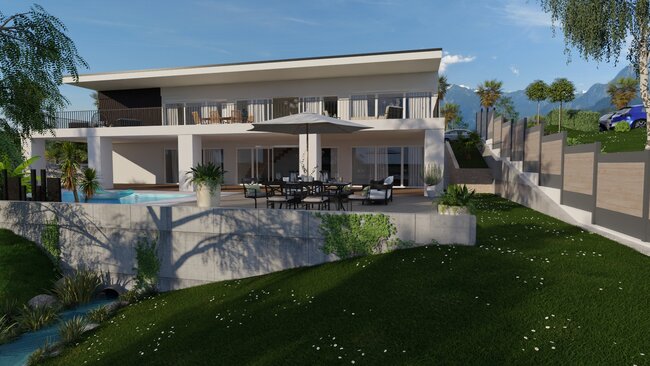
About this Green Feature:
Low-emittance (Low-E) windows are designed to reflect heat while letting natural light in. These windows are coated with a special layer that reduces heat transfer to keep interiors warmer in winter and cooler in summer. They’re a key feature you need to consider for sustainable buildings because they help lower energy consumption for heating and cooling.
Tips for Incorporating this Green Feature in Your Projects:
- Optimize Window Placement: Position Low-E windows in areas with high sun exposure to reduce heat gain during summer months.
- Use Double or Triple Glazing: Opt for multi-pane Low-E windows for better insulation and more energy savings.
- Pair with Insulated Frames: For maximum efficiency, combine Low-E glass with insulated window frames.
8. Energy-Efficient Lighting
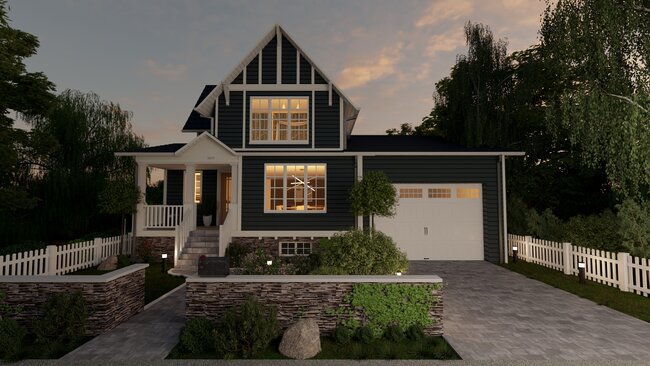
About this Green Feature:
Energy-efficient lighting, like LEDs, has become a staple in almost all green buildings. These lights use only a fraction of the electricity that traditional bulbs use and also last much longer, making them both eco-friendly and cost-effective. They also generate less heat, which means there’s less strain on cooling systems.
Tips for Incorporating this Green Feature in Your Sustainable Building Projects:
- Install Motion Sensors: In less frequently used areas like hallways, motion sensors can turn lights on and off automatically to reduce wasted energy when lights are on when no one is present..
- Choose Dimmable Lighting: Dimmable LEDs allow for greater control over light levels and help you save energy when you don’t need full brightness.
- Maximize Natural Light: Design spaces to take full advantage of natural light. This improves indoor environmental quality and reduces the need for artificial lighting during daylight hours.
9. Cool Roofs
About this Green Feature:
Cool roofs are designed to reflect more sunlight and absorb less heat compared to traditional roofing materials. They use reflective surfaces like specialized coatings, tiles, or light-colored shingles to reflect visible and infrared sunlight. This makes them especially valuable in warmer climates where lowering indoor temperatures can greatly reduce air conditioning use. Also, by installing a cool roof, you help mitigate the urban heat island effect.
Tips for Incorporating this Sustainable Design Feature in Your Projects:
- Choose High-Reflective Materials: Opt for reflective coatings or light-colored roofing materials that are designed to bounce more sunlight away from the building.
- Light-Colored Asphalt Shingles: Choose shingles with lighter colors or at least cool-colored granules.
- Consider Roof Slope: If your project involves a flat or low-sloped roof, a cool roof can provide even more energy savings since these surfaces tend to absorb more heat.
- Maximize Ventilation: Pair a cool roof with proper attic ventilation to allow excess heat to escape.
10. Waste Management
About this Green Feature:
Effective waste management is a cornerstone of sustainable building. This starts from the very beginning of a project and involves strategies to minimize the waste generated during both construction and daily operations. By reducing, reusing, and recycling materials, you can significantly lower your project’s environmental footprint. For sustainable construction, consider initiatives like on-site recycling, waste separation, and using repurposed materials.
Tips for Incorporating this Initiative in Your Sustainable Building Projects:
- Create a Recycling Program: Set up dedicated bins on-site for separating and recycling materials like metal, wood, and concrete.
- Use Recycled or Repurposed Materials: Source materials like reclaimed wood or recycled steel to reduce the demand for new resources.
- Plan Ahead for Waste: Collaborate with contractors early on to create a waste management plan that reduces unnecessary material usage and waste.
Start Including Green Features In Your Builds Today
Whatever your objectives are for pursuing green building design — improving indoor environmental quality, creating resource-efficient commercial buildings, or improving your building’s life cycle, Contemporary Style Design can help you get there. With Contemporary Style Design’s 3D home design software, you can easily integrate sustainable elements into your green building projects.
See why more housing PROs are making the switch to Contemporary Style Design software.
- Create an entire set of 2D and 3D designs in as little as 2 hours
- Quickly generate photorealistic 3D renderings that wow clients and land you more jobs
- An extensive design library with elements like biophilia for green buildings
With a FREE version, you’ve got nothing to lose. Try Contemporary Style Design now!




